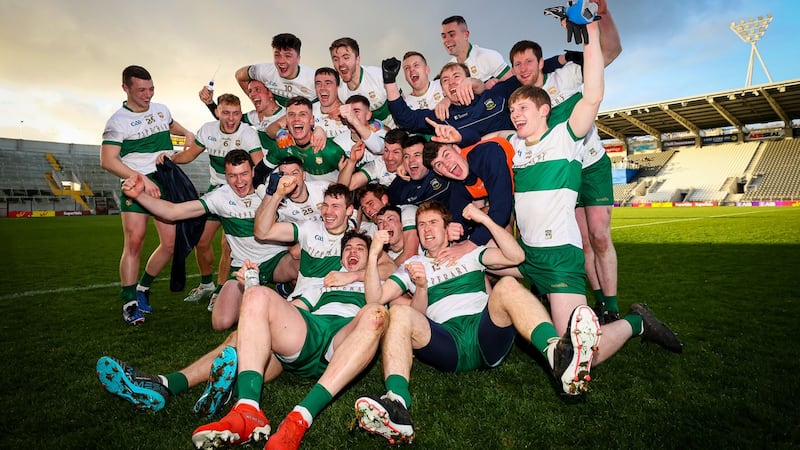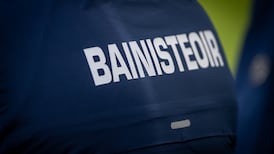It’s a regular occurrence within the GAA that history chimes in on important anniversaries or repeats itself at apposite intervals but there’s hardly been anything like the events of the weekend just gone.
In one obvious sense it was a shame the Bloody Sunday commemoration fell in a time of pandemic with virtually no one present because it meant that not even the families of the dead could attend.
Yet for those fortunate enough to be present there was an eerie silence about the occasion, almost as if the stadium – unrecognisable after a century of development but resolutely occupying the same footprint of land – was itself remembering the most terrible events to which it had borne reluctant witness.

Two friends separately messaged to say that they had been left teary-eyed watching on television the 14 flames flickering in the background as Brendan Gleeson read Michael Foley's resonant tribute to the fallen.
The latter, author of the definitive account of the day, The Bloodied Field, and effectively, cultural commissar for the centenary commemoration – although the GAA’s Cian Murphy should also be acknowledged – has always maintained in the six years since his book was published that a primary mission was to remember the dead.
Historian Mark Duncan, a contributor to Saturday's radio coverage, coined a wonderfully apt phrase, saying of the victims that Michael Hogan had been remembered by name and the others by number: Mick Hogan and 13 others.
Even on the 50th anniversary in 1970, The Irish Times records the unveiling of two plaques, one with the names of the dead and the other carrying the teams but the report, which elsewhere refers to Hogan simply says of the plaque, ‘the names of the 13 who died’.
Peculiarly, and almost confounding Mark Duncan's remark, the plaque didn't even include the name of Tom Hogan, the Limerick mechanic who was the last of the victims to die. There is no official explanation for this but Michael Foley makes the point that when he began to research the Bloodied Field, he had first to ascertain exactly how many had died given the confused accounts.
The centenary weekend will live in the sporting memory though for the events of Sunday afternoon. The quartet of Cavan, Dublin, Mayo and Tipperary has contested All-Ireland football semi-finals just once in the 133-year history of the championship and that was 100 years ago.
It’s Dublin’s 11th semi-final on the trot and Mayo’s ninth in the same period but Cavan and Tipperary both started as 500-1 shots for the All-Ireland and 20-1 and 16-1 respectively for their provincial titles.
In historic terms the following might usefully be noted.
Tipperary
It was fitting that one of those bred-to-the-bone Tipp football men, David Power, who had delivered the 2011 All-Ireland minor miracle, was manager for this day of days but in focusing on 85 years ago when the county last won the Munster title, rather than the big centenary he was selling his achievements short.
In 1935, Kerry boycotted the Munster championship in political protest at the treatment being handed out to Republican prisoners by the De Valera government.
“There’s no need to bring that up!” said Séamus McCarthy, chair of Tipperary’s Bloody Sunday commemoration committee and another keeper of the county’s football flame, last week when talking about Tipp’s roll of honour.
But it underlines the achievement. This year Munster had a full field running and still Tipp won.
In so doing Tipperary bridged the biggest ever gap between provincial football titles and within Gaelic games only the Derry hurlers’ 98-year wait for an Ulster hurling title in 2000 exceeds it.
There’s further historical echo in the fact that after the great influenza pandemic of 1918-19 struck, Tipperary reached the All-Ireland final against a Wexford team about to set a great GAA landmark by winning four-in-a-row.
The flu caused the postponement of the final until January 1919 and one of Tipp’s key players, top scorer Davy Tobin, who hit two goals in the defeat of Mayo in the semi-final, couldn’t play in the narrowly lost final because of the virus.
This year, another pandemic-delayed championship balanced the scales of history. Unable to travel overseas because of the pandemic, All Star forward Michael Quinlivan became available, as did Liam Casey, Colin English and Paudie Freehan. The same circumstances made Colin O’Riordan available, as it was the AFL close season in Australia and his club Sydney Swans allowed him to play out the championship.
Mayo
Mayo in 1916 became the first Connacht team to qualify for the All-Ireland final, which that year set a record by being played so late – December 17th, a mark that will 104 years later be broken when the 2020 final happens on 19th of next month.
Croke Park was sheeted in ice and the match only got the go-ahead about an hour before the throw-in.
Having lost the 1920 semi-final to Tipp in 1922 – it wasn’t played until 20 months after Dublin beat Cavan in the first semi-final – Mayo would be wronged in the eyes of many three years later when an All-Ireland that looked to have been awarded to the county was taken back and given to Galway after an exhausting series of committee-room wrangles.
Cavan
When Cavan last won Ulster, it happened to fall on the 50th anniversary of the 1947 Polo Grounds All-Ireland against Kerry and as the county had also been promoted to Division One of the NFL, it meant that a league match between the counties could be set up to mark the golden anniversary in New York because of this coincidence of history.
Given all of the discussion about moving the match from Croke Park to Páirc Tailteann to reduce Dublin’s advantage, it should be noted that the 1920 All-Ireland semi-final was played at the Navan venue.
Dublin
Dublin would lose the 1920 All-Ireland final to Tipperary when it was played in June 1922 but the group of players went on to become the county’s most dominant side until the last decade, winning three-in-a-row.
Would the champions consider travelling to Cavan to play? It sounds unlikely but in 1933, a Kerry team in pursuit of five-in-a-row agreed to play the All-Ireland semi-final against the Ulster champions in Breffni Park.
Dublin might be mindful that a last-minute goal handed Kerry a first championship defeat in five years. It would however be a grand gesture in this most unusual year.
A genuine 2020 vision.
e: smoran@irishtimes.com













